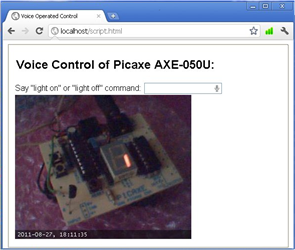Uploaded
Submitted by: Tayeb Project Website: https://redacacia.wordpress.com/2010/08/05/internet-control-of-a-picaxe
Uploaded
Submitted by: Tayeb Project Website: https://redacacia.wordpress.com/2010/08/05/internet-control-of-a-picaxe
Objectives
Experiment with speech recognition in order to control an electronic device remotely through Internet, and demonstrate new functionalities of Google Chrome 11 browser supporting voice-to-text and HTML5.
Introduction
In April 2011, Google released version 11 of the Chrome browser. One of the most important addition to the new version of Chrome browser is the support for speech recognition. One can enable speech recognition with a simple tag.
Google is effectively using the WebKit layout engine, first released as a beta version by Microsoft Windows in September 2008, and the public stable release was released in December 2008.
The electronic setup
An AXE050 board with Picaxe18M microcontroller is used.
The firmware in AXE-050 is the same as we used in Internet Control of a Picaxe. The idea behind using the same firmware without modifications, is to use it in future voice operated projects (if I get time for them…)
The main server
A Windows-based XAMPP server is installed in the PC.
The server is hooked to a local network with a fixed local IP. The application is situated in a network that has no fixed public IP, hence DynDNS services is used. The router routes all external demands to the fixed local IP.
Windows XP and later do not allow easy RS232 control through Internet. To overcome such a blockage, RS232 control is done through DOS, using Kermit for DOS. Kermit scripts are run by PHP, to control AXE050.
Conclusion
We have experimented with voice (speech) recognition. The technology has not come to age yet. One has different accents and pronunciations (mine is a big mixture!) and it is a huge task to recognise all of differing human voices.
The interaction with devices adds an extra dimension to voice recognition. Chrome 11 browser’s support for speech to text is not well documented. but gradually its potential is being discovered and shared.
Share